Great mascot design is like a symphony of great ideas. The client is the catalyst and from their imagination ideas spring forth which mascot designers arrange to create memorable characters that endure in our hearts and minds. But what goes into a great mascot design? How are raw ideas forged into final characters? Let’s take a look at both the design of cartoon mascots and mascot costumes.
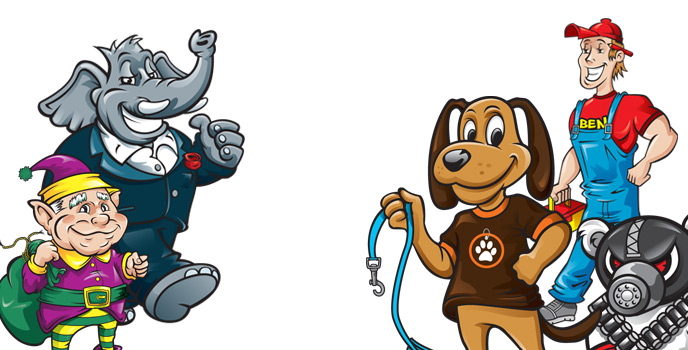
For some organizations, the mascot design they need has nothing to do with a physical suit or costume. What they need is a cartoon mascot to professionally represent a product or service or even a concept such as safety.
These kinds of two dimensional mascots are much easier and faster to create since they don’t require the complex costume to be made. There are many companies like ours specialize in cartoon mascot design services who can help you. But how do you go from having an idea for a mascot to actually having one designed and completed for you?
IMPORTANT TIP!: If you are hiring a company to design a cartoon mascot for you then choose a company, studio or designer that has a solid portfolio of mascots which exemplifies the style of mascot you are after. The reasoning here is two fold. Firstly, all artists have their own style which they are good at (and it’s often difficult for them to create outside of that style). Secondly, if you like the style of what you see in their mascot portfolio then you have a good idea of what you can expect for your mascot.
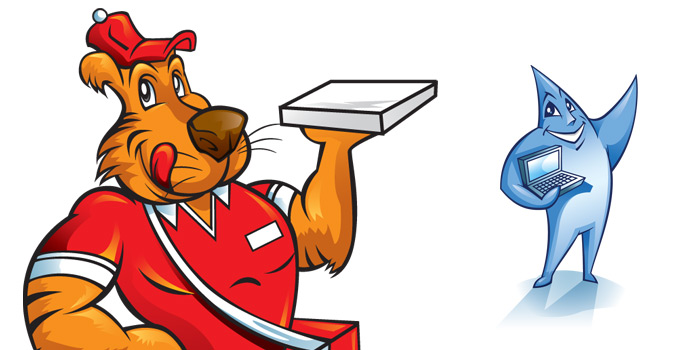
Discovery Phase
All mascots start off with something in common; an idea. Your idea for a mascot might come from you as an individual or from a group or a committee who are wanting to turn that idea into a tangible character. This is all good and normal!
A mascot design company will perform discovery in their own way. What we do at this Phase is allow a transfer of your ideas to our artists with what we call our “Character Planner”. The Character Planner essentially let’s us “download” the ideas from your brain (or collective wisdom). It’s a simple and easy process which typically takes from five to fifteen minutes. Your ideas establish what we call the “Creative Brief” for your mascot design. Think of this Creative Brief as an assignment for your artists to fulfill. They read the brief and then get to work interpreting the ideas into tangible artistic concepts for you. We call this the Sketch Phase and it’s where things start to get fun!
Sketch Phase
Every mascot design company or studio handles this “sketch” or “concept” stage differently too. What we do at FastCharacters is go for shock and awe. Rather than a single artist, we assign a minimum of four artists to your mascot design. Each of these four artists interprets your ideas from the Character Planner and creates a totally unique concept sketch.
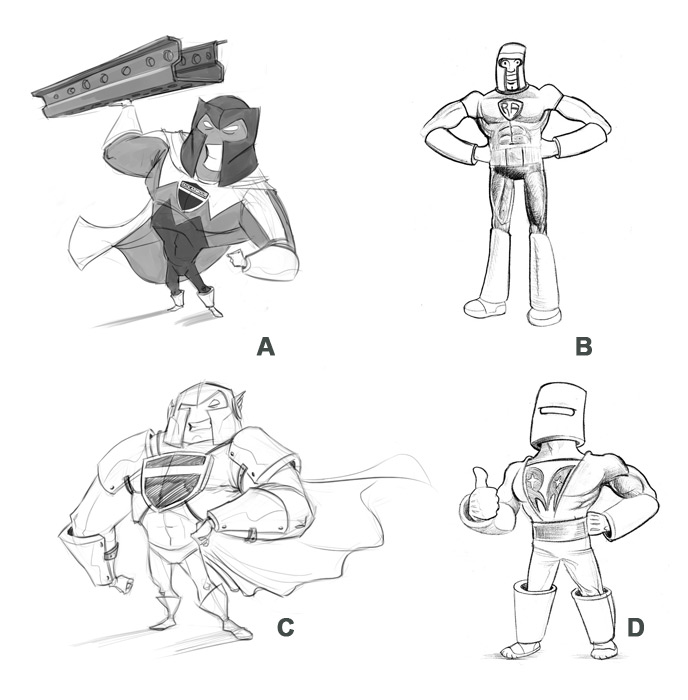
Mascot design sketches for “Rack Armour Man”
Your mascot design comes to life in four different ways from four completely different perspectives. We love this approach because each artists has a different creative point of view and it means we can pitch four different mascot designs right off the bat!
These concept sketches are done as you would expect. They are completed using traditional methods; by hand using pencil and paper. Your artists take the information in your Character Planner and explore these details on paper. And don’t worry, if you aren’t sure how many fingers or what facial expression your mascot should have, your artists are happy to provide their creative input and provide solutions. You can give them as much or as little creative freedom as you wish.
Like most mascot designers, we present concept sketches for your review. From there we encourage you to choose one or mix and match between them. Your feedback might look something like:
- “Keep the head from sketch A and the body from sketch C “
- “We want to see a completely new helmet!”
During the Sketch Phase we encourage you to make as many changes as you like in order to explore the options you want to see. TIP: The freedom to make unlimited revisions isn’t typical (yes, we’re special like that) so make sure you ask your mascot designers what their revision policy is.
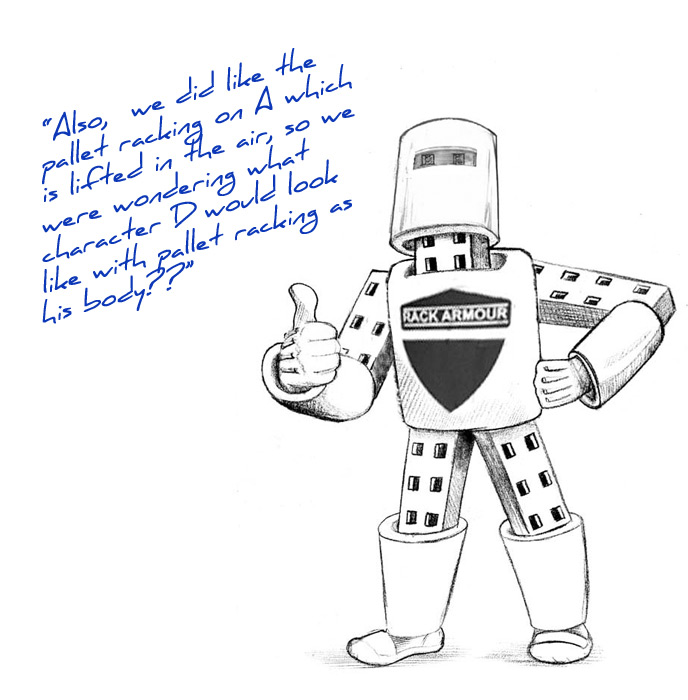
Mascot design edits and refinements for “Rack Armour Man”
Our clients request all kinds of edits and we’re happy to accommodate them. We want you to explore what your character design will look like any way you can imagine it! Once a sketch is narrowed down, you can request all kinds of final edits. Here’s what typical feedback might look like
– Slightly larger eyes
– A more assertive stance
– Slightly wider smile
– Lift the left arm a bit
After seeing this revision you might cheer hooray for your mascot design! When you are happy you give your approval because now it’s time to move on and add the real magic during the Color Phase!
Color Phase
So this is probably my favorite part of the whole character design process. This is where you see your pencil sketch mascot concept really start to take a life of it’s own. The rough sketch is vectorized; which is a geeky work meaning “digitized as points and lines”. Vectors are awesome to have with your mascot design because they allow you to scale your character as small or as large as you want with no loss in quality. For example, you can use your mascot in small digital spaces like websites through to large scale applications like vehicles and billboards.
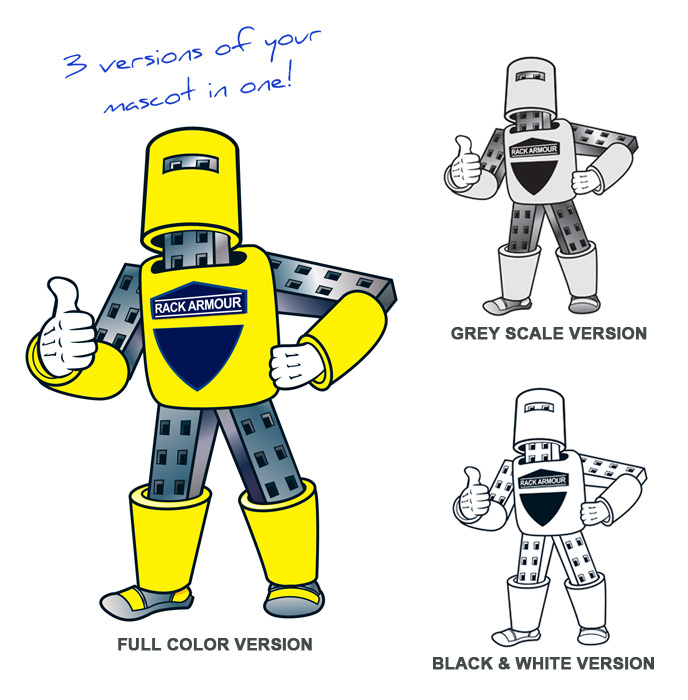
Final “Rack Armour Man” with all color versions.
So, vectorizing is the first step in colorizing your mascot. Once the outlines (the vectors) are there, your artists now proceed to rendering. Rendering is the act of adding color and shading to your mascot. There are a number of ways this can be done.
The first thing to decide is whether your mascot will have an outline, or not. Below you can see three examples. The tiger mascot on the left (“Takeout Tiger”) has a bold black outline. The Cochlear implant mascot has a more subtle, gentler brown outline. And lastly, the male fitness character has no outline at all. So which do you favor in a cartoon mascot illustration? My favorite is the black outline style. Maybe it’s because I grew up reading comic books. Maybe it’s because visually, it’s just a really strong style and I love that about it.
TIP: If your mascot is to be used as a brand extension then naturally any existing elements of your brand (colors, logo) will be a factor in which options you choose during the color phase.
Next up it’s about choosing the kind of color (or fill) you want on your mascot character. When it comes to color there are two options to choose from.
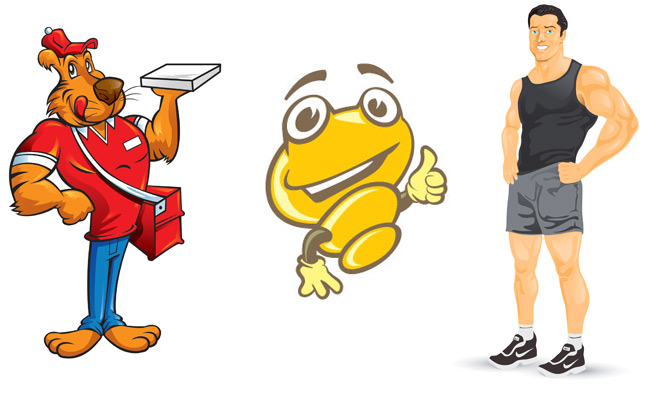
Coloring techniques for custom mascots (from left to right): Outline plus gradients/shading, flat color, just gradients
Flat Color
An tried and tested technique, flat color results in a look that is more traditional. Cartoons and comics of yesteryear were filled with flat color and this simple technique is still just as relevant today as it ever was when it comes to coloring your custom mascot. Yes, there are fancier looks out there but don’t discount the appeal and more importantly, the longevity of flat color.
Gradients
The style of the day is definitely gradients. Gradients allow you to shade your character design with modern finesse. These gradients give your mascot depth and a contemporary look and feel that is tough to beat. Mascots with gradient fills look like they have a lighting source and shading. All of which adds another element of visual interest and makes the mascot even more sticky!
Delivery Phase
OK so this is the last and easiest phase in a mascot design project. The delivery phase is how your completed mascot character is handed off to you, the client. Different mascot design companies will handle this phase different. We can only speak for ourselves but we go the extra mile here by delivering our cartoon mascots in multiple vector and bitmap file formats along with making sure that you’ve got a beautiful full color version, a functional greyscale version and a very versatile black and white version.
Alright, for some of you a cartoon mascot is all you’ll need. For others, it’s the first in the journey to creating a physical costume that you can wear! Let’s take a look at the design process for mascot costume design!
Mascot costume design
Beyond two dimensional character designs are actual mascot costumes. These costumes are designed to meet and greet people on the street, at a mall or a theme park. Then there are the performing mascots who are expected to do cartwheels and somersaults while entertaining a crowd.
Each mascot costume is designed with a specific purpose in mind. Here are common questions which differentiate between the requirements (and often costs) associated with different mascot costumes:
Is the costume to be used indoors or outdoors or both?
This question allows your designers to make important choices about materials. A costume exposed to the weather has to not only resist the elements and provide comfort for the performer on the inside! Choosing the right materials for the application of the costume means it stands the best chance of a long and healthy life.
Is the costume for a meet-and-greet mascot or a performing mascot?
Now you can see how important asking this question is. A costume made for greeting people at a mall can be made with inexpensive materials and construction techniques. That’s not to say your mascot costume will be made cheaply (although it can if you aren’t careful), it simply means that the best value materials are chosen for the suit..
Material selection
This is a crucial aspect of any mascot costume design. Material selection affects:
- The comfort of the performer wearing the costume
- The portability of the costume
- The durability and longevity of the costume
- The cost of the costume
A mascot costume which is intended to perform acrobatics on a football field with temperatures ranging from a hot summer’s day to a cold snowy evening needs to be designed with the best of everything. Compare that to a mascot standing and waving to kids inside an air conditioned mall and you can see where the difference in cost comes into play with material selection, comfort and durability
It’s pretty easy to forget that inside those mascots we love, there is a human being doing a job. How much a gusto and earnestness a performer puts into their duties as a mascot can simply come down to how comfortable they are. An uncomfortable performer is much more likely to drag their feet, count the minutes until their shift is over and look for another job. A comfortable performer is more likely to put in a solid shift and get into the groove of being a mascot. So it’s important to understand, nothing effects comfort more than the material selection and build quality.
Imagine you are inside a poorly designed mascot costume in the middle of July. The fabric in contact with your skin is poor quality and making you itchy. It’s hot outside and the suit has no proper ventilation and you’re breaking out in a sweat. Sounds awful right? Now compare that to a suit that’s been designed with that environment in mind. The suit is made from low allergenic materials which breath and encourage air flow. There is no itching and there is always a steady flow of fresh air into and out if the costume. Perfection!
Build Quality
Of equal importance is the quality of the build. There are lots of places a cheap mascot costume company can cut corners. Build quality affects not only the life of the costume but also performer comfort. If the quality of the mascot costume is low then you’ll be paying for another costume sooner rather than later. Better to pay a bit more up front with a reputable mascot designer and get a costume that will go the distance. Also, cutting corners in build quality can result in uncomfortable performers who won’t stick around to wear your cheap suit!
Here are some of the questions you’ll want to ask in order to find out about the build quality of your mascot:
What materials will my mascot costume be made from?
Inside the mascot head, what kind of helmet is used?
How will you fasten the mascot head onto the costume?
How are the mascots hands, head and feet attached to the feet of the performer?
Does my mascot costume come with built-in muscles or a body liner?
Make sure the company you are dealing with can provide you clear and confident answers to these questions. You want to be left with no doubt that you are dealing with a professional company that will promptly and honestly answer your questions now and in the future.
Transport Considerations
Another important factor is whether you expect your mascot costume to stay in one place or whether you expect it to travel. As you can imagine, packing a mascot costume for travel can add certain stresses on the costume and your mascot designers should know ahead of time whether this is a consideration. They can make the necessary accommodations during the design phase and also provide you with any special bags, cases and travel accessories in order to protect your mascot during transport. Remember, this is particularly true with air travel. We call them “baggage handlers” but they refer to themselves as “throwers”!
End of Mascot design 101
OK so we hope you have a better idea of what mascot design is all about and what goes into designing great mascots. It’s a beautifully creative industry we’re in and we love helping you get into the best possible mascot to suit your needs.

Pingback: A Free Premium Mascot Design | EliteFreelancing.com
Pingback: The Most Famous Cartoon Characters & Mascots – Part 2 - Fast Characters